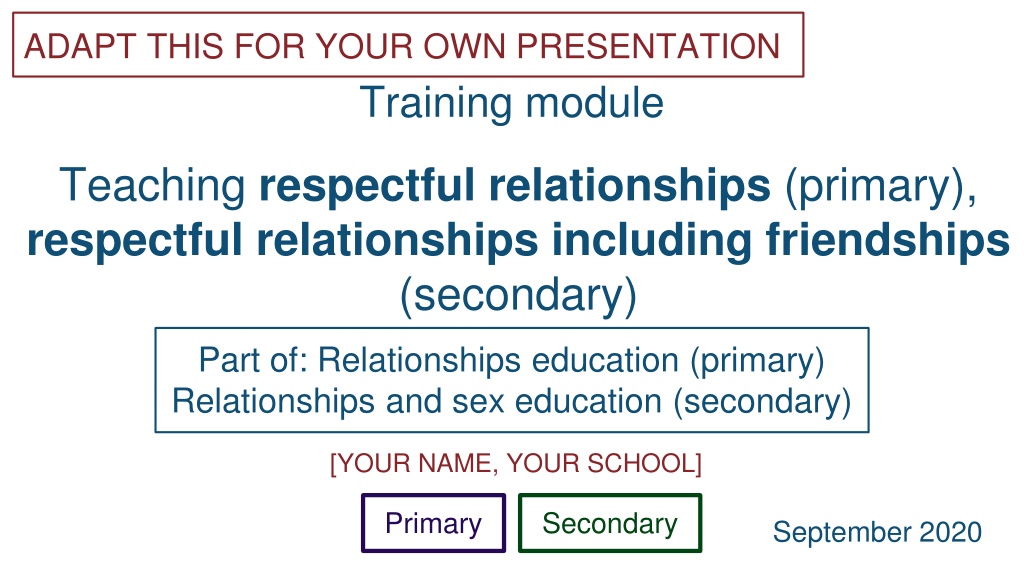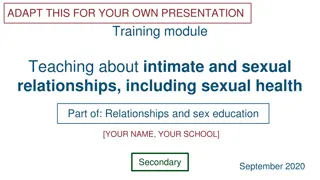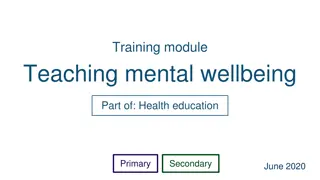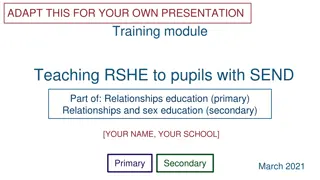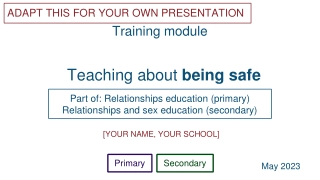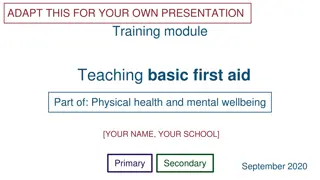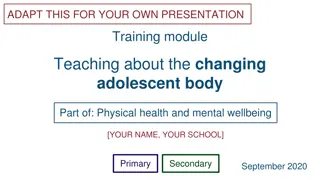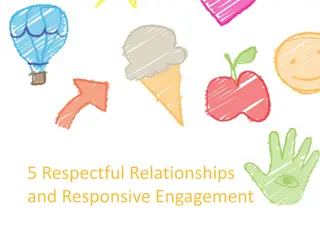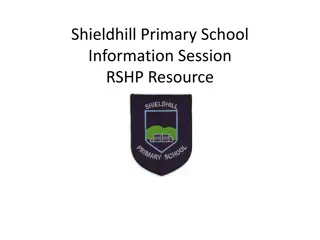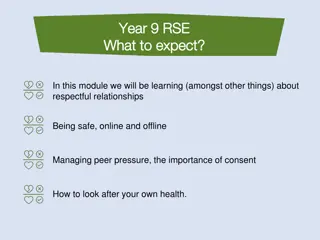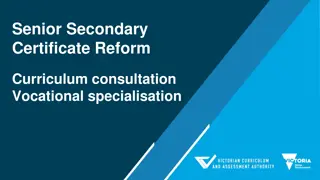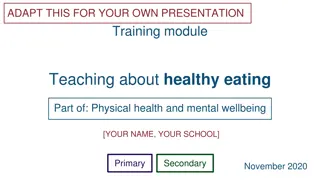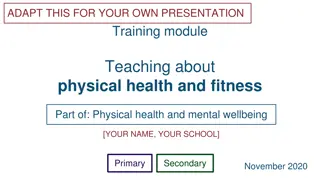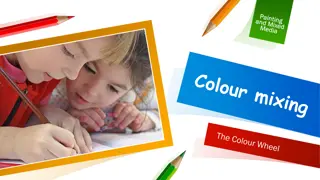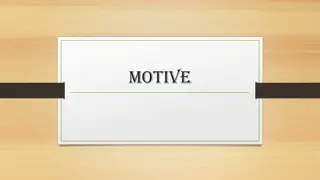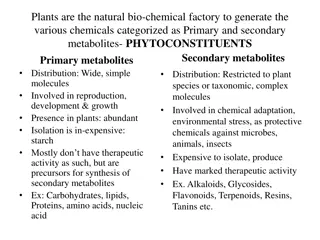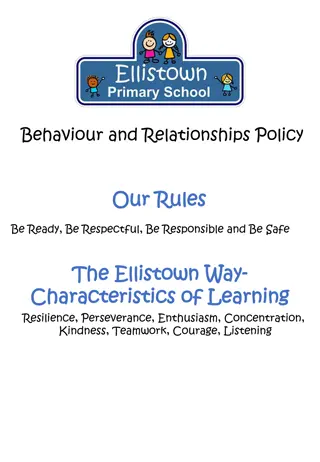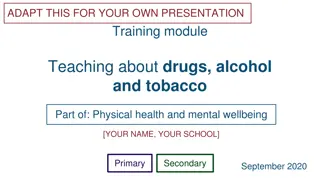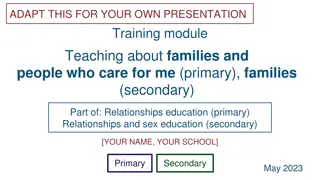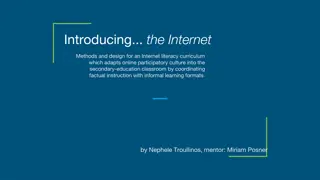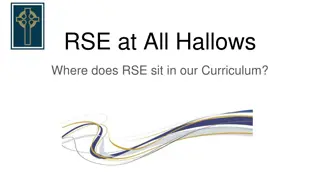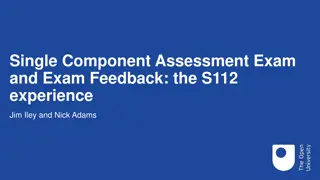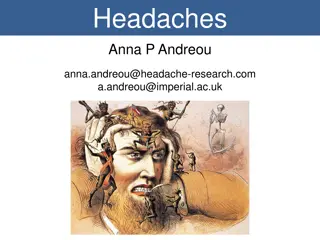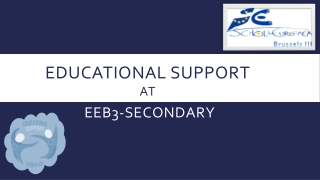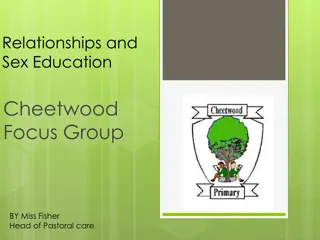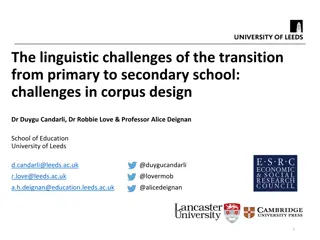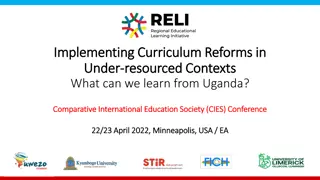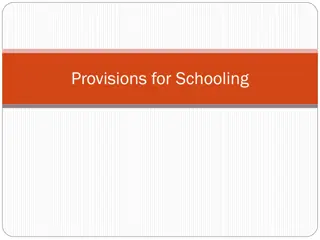Teaching Respectful Relationships: Primary and Secondary Curriculum Training Module
This training module focuses on teaching respectful relationships, including friendships, for primary and secondary school students. It covers key knowledge, strategies for handling class discussions, and ways to link topics across the curriculum. Schools can adapt this non-statutory guidance to complement statutory teaching on respectful relationships. Consideration of related topics and guidance on bullying prevention and online safety are also provided.
- Respectful Relationships
- Training Module
- Primary Curriculum
- Secondary Curriculum
- Relationship Education
Download Presentation

Please find below an Image/Link to download the presentation.
The content on the website is provided AS IS for your information and personal use only. It may not be sold, licensed, or shared on other websites without obtaining consent from the author. Download presentation by click this link. If you encounter any issues during the download, it is possible that the publisher has removed the file from their server.
E N D
Presentation Transcript
ADAPT THIS FOR YOUR OWN PRESENTATION Training module Teaching respectful relationships (primary), respectful relationships including friendships (secondary) Part of: Relationships education (primary) Relationships and sex education (secondary) [YOUR NAME, YOUR SCHOOL] Primary Secondary September 2020
Contents 3 About this training module 5 Teaching the new curriculum 14 Safeguarding 17 Ground rules 20 Primary curriculum 41 Secondary curriculum 69 Examples of good practice 75 Activities and templates for trainers 2
About this training module Subject leads can use the adaptable slides and activities and templates for trainers section at the end of this module to help shape training sessions for teachers. This non-statutory training module supplements the statutory guidance on teaching about respectful relationships, which schools should read in full. Schools can choose whether and how to follow or adapt this training module and should refer to the Early Career Framework for pedagogical guidance. 3
What you get out of today By the end of this training you should: know what is included in the statutory guidance know some key knowledge and facts to cover as part of this topic have strategies to deal with questions that come up in class feel more confident teaching about respectful relationships 4
Closely related topics Respectful relationships is related to the modules: online relationships mental wellbeing being safe intimate and sexual relationships (secondary only) caring friendships families and people who care for me Therefore you should: consider thematic links across key topics and the whole school when planning and delivering lessons find ways to link knowledge and vocabulary across topics 6
Related guidance Schools may also want to refer to the following related guidance when planning to teach this subject: Guidance for schools on preventing and responding to bullying (including cyberbullying) Teaching online safety in school 7
Relationships support at [school name] Our leads [Names, contact details of relationships support] Our policies [Add details - e.g. school policy on bullying] Specialist support [Add details - e.g. providers school already works with] Other information [Add resources] 8
Teaching about respectful relationships at [school name] Ways in which we already teach about respectful relationships at our school: [add details] [add details] [add details] 9
Taking a whole school approach The importance of respectful relationships should be: incorporated within the school s behaviour policy championed by teachers and everyone at the school a central part of the school's culture, ethos and expectations modelled in all interactions and reflected in relevant policy documents Many of the points within this module can be illustrated and discussed in class using case studies or examples from film or literature. 10
Primary and secondary teaching Some slides in this training have a Primary or Secondary label to indicate that the material is usually first introduced in that phase. STATUTORY GUIDANCE Schools have flexibility to design and plan age-appropriate subject content. (p31) Using your knowledge of your pupils and school community you can: introduce secondary content in primary with pupils who need it and are ready teach the primary content in early secondary lessons to pupils who need to build knowledge before secondary content is taught 11
LGBT needs and inclusion Primary schools are enabled and encouraged to cover LGBT (lesbian, gay, bisexual and transgender) content if they consider it age appropriate to do so. Secondary schools should include LGBT content. When doing so, schools should ensure: LGBT-relevant knowledge and examples are included throughout programmes of study (not one-off teaching) inclusive language is used, considering how individual pupils may relate to particular topics 12
Pupils with SEND You will need to plan lessons to allow all pupils to access and practise the core knowledge, using your expertise as you normally would. You might want to link lesson outcomes with statutory preparing for adulthood outcomes for those with an education, health and care (EHC) plan. (See SEND code of practice, section 8.) STATUTORY GUIDANCE In special schools and for some SEND pupils in mainstream schools there may be a need to tailor content and teaching to meet the specific needs of pupils at different developmental stages. As with all teaching for these subjects, schools should ensure that their teaching is sensitive, age-appropriate, developmentally appropriate and delivered with reference to the law. (p15) 13
Safeguarding 14
Safeguarding (1) Pupils may be affected by issues discussed in lessons. Let your designated safeguarding lead or deputy and any other relevant staff, such as pastoral leads, know what you are teaching. This will enable them to identify and speak to relevant pupils, especially those who they know may have been directly impacted by issues covered in the lessons and those with adverse childhood experiences. Teachers may need to deal with disclosures/concerns (e.g. of abuse or offending behaviour) in a way that safeguards pupils in line with school policies, especially the child protection policy. 15
Trusted adults Within this module we have used the term trusted adult. A trusted adult will generally be someone who children feel comfortable to turn to for help. Obvious examples include family members, teachers and doctors. It will be important when teaching this topic, and any other relevant topics, that teachers explore this concept. Pupils should be comfortable and capable of identifying who their trusted adults could be, both within their families and wider circles. 16
Ground rules 17
Create class ground rules Clear class ground rules can help when teaching about sensitive topics. They also support confidentiality and safeguarding of pupils. Good practice is for ground rules to be: discussed and understood by all clear and practical modelled by the teacher followed consistently and enforced updated when needed visible in lessons (for example, posters) 18
Example ground rules Respect privacy. We can discuss examples but do not use names or descriptions that identify anyone, including ourselves. Listen to others. It is okay to disagree with each other, but we should listen properly before making assumptions or deciding how to respond. When disagreeing, challenge the statement not the person. No judgement. We can explore beliefs and misunderstandings about a topic without fear of being judged. Choose level of participation. Everyone has the right to choose not to answer a question or join discussion. We never put anyone on the spot (no personal questions or pressure to answer). 19
The importance of respect STATUTORY GUIDANCE Know the importance of respecting others, even when they are very different from them (for example, physically, in character, personality or backgrounds), or make different choices or have different preferences or beliefs. Explain that respect means being considerate of the wishes, feelings and needs of another person. Teach that mutual respect is fundamental to building all healthy friendships and relationships. Discuss some characteristics of a positive: friendship, e.g. enjoying time together family relationship, e.g. love and trust relationship with someone else, e.g. feeling supported by a teacher Explain to pupils that in school and in wider society it is important to show respect and feel respected by others. Primary 21
Boundaries and personal space STATUTORY GUIDANCE Know the importance of respecting others, even when they are very different from them (for example, physically, in character, personality or backgrounds), or make different choices or have different preferences or beliefs. Teach that a key part of a healthy relationship is to respect each other s personal space and boundaries. Explain that everyone has the right to have their own boundaries, for example: to share some of their toys, but not all of them to choose how much physical contact they have, e.g. some people like to hug, but other people prefer to just wave Explain the differences between appropriate and inappropriate or unsafe contact (in both physical and in other contexts, e.g. online). Primary 22
Respecting difference STATUTORY GUIDANCE Know the importance of respecting others, even when they are very different from them (for example, physically, in character, personality or backgrounds), or make different choices or have different preferences or beliefs. Teach that everybody is unique. For example, people: look different from each other like and dislike different things might have different beliefs or customs Explain that everyone needs to show the same respect to others, regardless of how different they are to them. Explain that targeting someone simply because you disagree with them is a form of bullying and not acceptable. Primary 23
STATUTORY GUIDANCE Know the importance of self-respect and how this links to their own happiness. Self-respect and happiness Explain to pupils that self-respect means valuing their own worth, needs and wishes. These are of equal value to anybody else s. Having self-respect and self-worth can help them to: be confident and happy feel that they matter empathise with others achieve personal goals be resilient Primary 24
STATUTORY GUIDANCE Know the importance of self-respect and how this links to their own happiness. Respect for ourselves and others Explain to pupils that practising respect for ourselves and others also means showing other qualities such as honesty, empathy, integrity, courage, humility, kindness, generosity, trustworthiness, tolerance and fairness. Explain each of these qualities to pupils and encourage active demonstration of these behaviours throughout the school community. Teach that they can develop these qualities by taking part in activities such as helping others and volunteering. Primary 25
Respecting people in authority STATUTORY GUIDANCE Know that in school and in wider society they can expect to be treated with respect by others, and that in turn they should show due respect to others, including those in positions of authority. Explain that all relationships benefit when respect is mutual and reciprocal. Teach pupils that it is courteous to respect those in positions of authority. Explain that the people within these jobs often have a responsibility to make other people s lives safe and secure. Teach that by respecting those positions we enable them to do this properly. Give some examples of people in such positions and explain why respect for them and the job they do is important. Primary 26
Improving relationships STATUTORY GUIDANCE Know practical steps they can take in a range of different contexts to improve or support respectful relationships. Teach pupils that all relationships (e.g. friends, family, online) can be supported by: being kind, considerate and respectful being honest listening to each other respecting personal space, privacy and boundaries accepting each other s differences focussing on the good things in each other praising each other on their achievements Primary 27
Supporting relationships STATUTORY GUIDANCE Know practical steps they can take in a range of different contexts to improve or support respectful relationships. Explain to pupils that when relationships have problems it may help them to: negotiate together and compromise not pressure each other to think or do something acknowledge when someone has done something wrong (including ourselves) and say sorry Teach pupils that mutual respect does not mean having to agree with someone and that their own needs are just as important. Primary 28
Courtesy and good manners (1) STATUTORY GUIDANCE Know the conventions of courtesy and manners. Teach pupils that there are conventions which are considered to be courteous and respectful, for example: saying please and thank you being on time, e.g. when meeting people taking turns, e.g. waiting for their turn to play with a toy not talking over or interrupting other people listening attentively when others are speaking using respectful language, e.g. not calling names being considerate of personal space and boundaries Primary 29
Courtesy and good manners (2) STATUTORY GUIDANCE Know the conventions of courtesy and manners. allowing other people to go first, e.g. through doors offering to help people where they can greeting people when they see them (e.g. good morning) and using their name asking for permission, e.g. would you mind if I ? Primary 30
Bullying STATUTORY GUIDANCE Know about different types of bullying (including cyberbullying), the impact of bullying, responsibilities of bystanders (primarily reporting bullying to an adult) and how to get help. Teach that bullying is behaviour: by an individual or group repeated over time which intentionally hurts another individual or group which can be either physical and/or emotional Teach that bullying is not the same as arguing with friends. Explain that bullying might be motivated by actual differences between children, or perceived differences. Teachers should read the guidance on preventing and tackling bullying. Primary 31
Types of bullying STATUTORY GUIDANCE Know about different types of bullying (including cyberbullying), the impact of bullying, responsibilities of bystanders (primarily reporting bullying to an adult) and how to get help. Explain bullying can take many forms, such as: physical, e.g. pinching, hitting, pushing verbal, e.g. name calling, spreading rumours non-verbal, e.g. staring at someone, making faces psychological, e.g. making someone feel bad about themselves, trying to control what someone does or says, regularly excluding someone Teach that it is not always possible to tell if someone is hurt by bullying, for example, they may laugh or smile. Explain that bullying is always harmful. Primary 32
Cyberbullying STATUTORY GUIDANCE Know about different types of bullying (including cyberbullying), the impact of bullying, responsibilities of bystanders (primarily reporting bullying to an adult) and how to get help. Explain that cyberbullying is bullying which takes place online, e.g. social media, texts, emails or in online games. Bullying online is just as serious as bullying offline. Explain that someone can be cyberbullied by people they know or don t know, including people who are anonymous. Cyberbullying includes: sharing or making offensive or hurtful comments pressuring someone into doing something sharing someone else s private messages or images without their consent Primary 33
The impact of bullying STATUTORY GUIDANCE Know about different types of bullying (including cyberbullying), the impact of bullying, responsibilities of bystanders (primarily reporting bullying to an adult) and how to get help. Teach that all forms of bullying are harmful, and can make those targeted: feel humiliated and ashamed feel scared, sad and alone feel like they want to hurt themselves or other people lose confidence in themselves miss school and other opportunities feel bad long after the bullying happens Primary 34
Responsibilities of bystanders STATUTORY GUIDANCE Know about different types of bullying (including cyberbullying), the impact of bullying, responsibilities of bystanders (primarily reporting bullying to an adult) and how to get help. Teach that a bystander is someone who witnesses bullying, but is not involved. Explain to pupils they can be an active bystander or a passive bystander. Work with pupils to understand the ways they can safely be an active bystander, for example: privately asking the victim if they're okay reporting it to a teacher (discuss the school's reporting procedure) telling a trusted adult encouraging the victim to contact an organisation like Childline Primary 35
Help for tackling bullying STATUTORY GUIDANCE Know practical steps they can take in a range of different contexts to improve or support respectful relationships. Explain your school s safeguarding, anti-bullying and behaviour policies. Teach pupils that they can speak to a trusted adult, or organisations such as Childline or CEOP. Explain that online bullying by a pupil at the same school can be reported to the school. Also discuss: digital reporting tools to remove content blocking certain users taking a break from online platforms taking evidence, for example, screenshots Primary 36
Understanding stereotypes STATUTORY GUIDANCE Know what a stereotype is, and how stereotypes can be unfair, negative or destructive. Teach that a stereotype is an overly simplified, often untrue, fixed idea about a group of people. Explain that a stereotype is a belief that someone's character, preferences, attributes or abilities can be automatically inferred from a group that they may happen to be a part of. For example, their gender or ethnic background. Primary 37
How stereotypes can damage STATUTORY GUIDANCE Know what a stereotype is, and how stereotypes can be unfair, negative or destructive. Teach that stereotypes are damaging for anyone in those groups as they: affect how people think about and behave towards them mean they are judged on assumptions about them rather than their own achievements and qualities make people look for behaviour in them that reinforces the stereotype of that group Teach that stereotypes are damaging and unfair whether they are applied to a group that is in the majority or the minority. Primary 38
Seeking permission STATUTORY GUIDANCE Know the importance of permission-seeking and giving in relationships with friends, peers and adults. Discuss with pupils when people need to seek permission from someone else, e.g. borrowing property, joining someone else s game. Discuss with pupils: what they should do if permission is unclear other ways that people say no , for example, maybe later or I don t know non-verbal cues, for example, people shaking their head, or saying nothing Teach pupils the importance of being clear when seeking permission, for example, by asking a direct question. Primary 39
Giving permission STATUTORY GUIDANCE Know the importance of permission-seeking and giving in relationships with friends, peers and adults. Explain to pupils that part of self-respect is knowing when they want to do something or not. Discuss ways they can express this with confidence and kindness. Teach pupils that: not giving permission does not make them a bad friend giving permission does not make them a good friend Primary 40
Secondary curriculum STATUTORY GUIDANCE Schools should continue to develop knowledge on topics specified for primary as required and in addition cover the following content by the end of secondary. (p36) 41
Positive and healthy friendships STATUTORY GUIDANCE Know the characteristics of positive and healthy friendships (in all contexts, including online) including: trust, respect, honesty, kindness, generosity, boundaries, privacy, consent and the management of conflict, reconciliation and ending relationships. This includes different (non-sexual) types of relationship. Building on what is taught in primary, teach that healthy friendships make people feel happy, confident, safe, and positive about themselves. Explain to pupils that this applies to relationships in person and online. Explore, in both contexts, what pupils can do if they are in a relationship that does not make them feel this way, for example, tell a trusted adult. Secondary 42
Positive and healthy friendships (1) STATUTORY GUIDANCE Know the characteristics of positive and healthy friendships (in all contexts, including online) including: trust, respect, honesty, kindness, generosity, boundaries, privacy, consent and the management of conflict, reconciliation and ending relationships. This includes different (non-sexual) types of relationship. In a positive and healthy friendship both people: are kind, considerate and respectful to each other are honest with each other listen to each other respect each others personal space, privacy and boundaries accept each other s differences Secondary 43
Respect STATUTORY GUIDANCE Know the characteristics of positive and healthy friendships (in all contexts, including online) including: trust, respect, honesty, kindness, generosity, boundaries, privacy, consent and the management of conflict, reconciliation and ending relationships. This includes different (non-sexual) types of relationship. Explain that in a respectful relationship they should be able to: express their feelings and opinions without being made to feel stupid, scared, or embarrassed listen to and genuinely value the other person s feelings and opinions be able to disagree without causing a fight or someone saying hurtful things Secondary 44
Respecting difference (1) STATUTORY GUIDANCE Know the importance of respecting others, even when they are very different from them (for example physically, in character, personality or background), or make different choices or have different preferences or beliefs. Building on the primary curriculum, reinforce that everyone needs to show the same respect to others regardless of how different they are to them. Explain the harm caused by cancel culture and the importance of freedom of speech and freedom of association to a tolerant and free society. Teach that censorship and no platforming are harmful and damaging. Explain that seeking to get people cancelled (e.g. having them removed from their position of authority or job) simply because you disagree with them, is a form of bullying and is not acceptable. Secondary 45
Boundaries, privacy, consent STATUTORY GUIDANCE Know the characteristics of positive and healthy friendships (in all contexts, including online) including: trust, respect, honesty, kindness, generosity, boundaries, privacy, consent and the management of conflict, reconciliation and ending relationships. This includes different (non-sexual) types of relationship. Teach that even within the closest friendships, people appreciate and expect to: have their privacy respected, e.g. trust that their friends will not access their phone without permission have their boundaries respected, e.g. how closely they interact with people, physically or otherwise be able to choose when to give and withdraw consent, e.g. change their mind Explain that this applies to all relationships, e.g. family, friends or other s they regularly interact with. Secondary 46
Conflict and reconciliation STATUTORY GUIDANCE Know practical steps they can take in a range of different contexts to improve or support respectful relationships. Teach that when there is conflict in relationships it can help to: apologise if they are in the wrong discuss ways to de-escalate conflict listen and acknowledge each other s viewpoints clarify views and opinions accept the consequences of their actions Explain that a successfully resolved conflict can strengthen a relationship as the parties understand more about the other person and themselves as a result. Secondary 47
Ending relationships STATUTORY GUIDANCE Know the characteristics of positive and healthy friendships (in all contexts, including online) including: trust, respect, honesty, kindness, generosity, boundaries, privacy, consent and the management of conflict, reconciliation and ending relationships. This includes different (non-sexual) types of relationship. Teach that friendships can end for different reasons: they can end suddenly, e.g. with a disagreement people can grow apart gradually as they develop different interests or priorities Explain that all people make and end relationships throughout their lives. After a relationship ends: learning to move on without ill-feeling is part of a mature response to these normal life events trying to maintain a relationship with someone who does not want to can be damaging for both people Secondary 48
Stereotypes damage individuals STATUTORY GUIDANCE Know how stereotypes, in particular stereotypes based on sex, gender, race, religion, sexual orientation or disability, can cause damage (e.g. how they might normalise non- consensual behaviour or encourage prejudice). Building on what is taught in primary school, teach that stereotypes are unfair, and can be limiting for the individual and for our society. These include stereotypes based on: sex gender disability race religion sexual orientation gender reassignment background Secondary 49
Stereotypes damage individuals (2) STATUTORY GUIDANCE Know how stereotypes, in particular stereotypes based on sex, gender, race, religion, sexual orientation or disability, can cause damage (e.g. how they might normalise non- consensual behaviour or encourage prejudice). Teach that stereotypes are unfair because people do not always fit into the idea that others may have of them. Explain that a lot of potential is wasted if people base their decisions on stereotypes rather than on an individual's strengths. Explain that it shows greater integrity to respect people s individuality rather than having preconceptions about them. Teach that stereotypes are damaging and unfair whether they are applied to a group that is in the majority or the minority. Secondary 50
